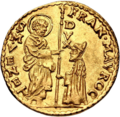Tarì

Al-Mustansir. British Museum
.
Tarì (from
Arabic طري ṭarī, lit. "fresh" or "newly minted money")[1] was the Christian designation of a type of gold coin of Islamic origin minted in Sicily, Malta and Southern Italy from about 913 to the 13th century.[2]
History
In the Islamic world, this type of coin was designated under the name ruba'i, or quarter-dinar, as it weighed 1.05 g (0.034 ozt) of gold.[1] The ruba'i had been minted by the Muslims in Sicily, unlike the Muslim rulers of North Africa, who preferred the larger dinar.[3] It became highly popular as it was smaller and therefore more convenient than the large-sized 4.25 g (0.137 ozt) dinar.[4]
The tarì were so widespread that imitations were made in Southern Italy (
carat gold (0.681 fineness) with some adjunction of silver and copper.[3] The tarì were also produced by the Hohenstaufens and the early Angevins.[6]
The tarì coins were generally minted from
Northern Africa in exchange for grain.[6]
Nowadays, the tari is a subunit (1/12) of the scudo, souvenir coins issued by the Sovereign Military Order of Malta.
See also
- History of coins in Italy
- Islamic contributions to Medieval Europe
- Norman-Arab-Byzantine culture
References
Citations
Works cited
- Blanchard, Ian. Mining, Metallurgy and Minting in the Middle Ages.
- Cardini, Franco. Europe and Islam.
- Grierson, Philip. Medieval European Coinage.
- Matthew, Donald, The Norman kingdom of Sicily Cambridge University Press, 1992
External links
![]() Media related to Tarì at Wikimedia Commons
Media related to Tarì at Wikimedia Commons

